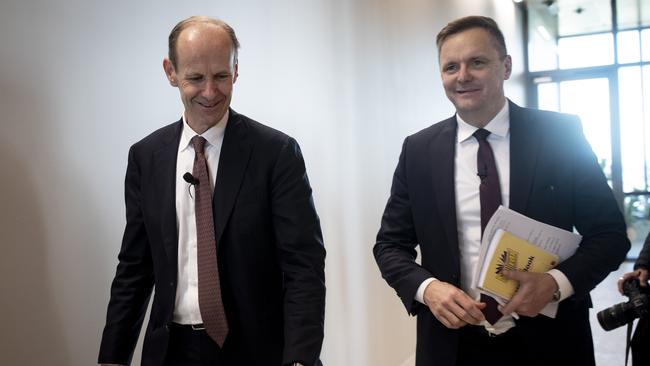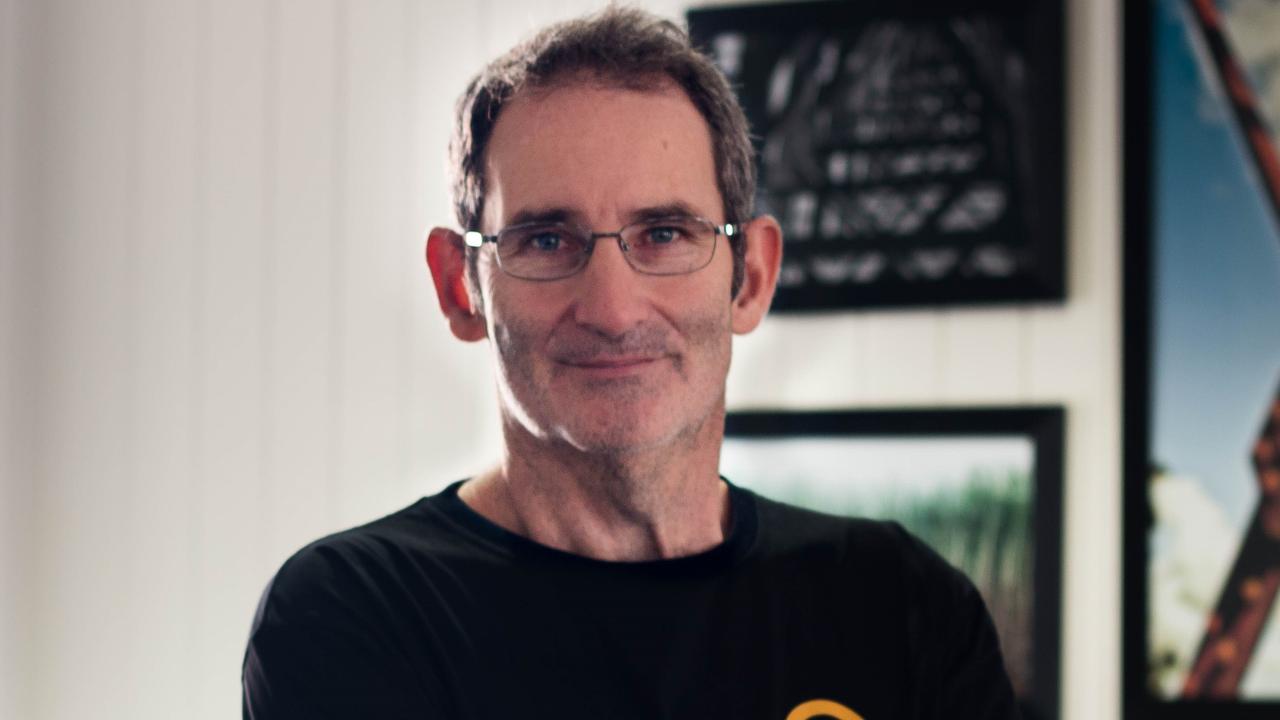As new Suncorp rises, CEO Steve Johnston ready to seize the moment
Steve Johnston has a once-in-a-generation chance to rebuild his insurer from the ground up. He just needs to bring investors along.

Business
Don't miss out on the headlines from Business. Followed categories will be added to My News.
For two weeks, Suncorp boss Steve Johnston has only been thinking about insurance. Believe it or not – that makes for a refreshing change.
In a $4.9bn deal full of twists and turns that was two years in the making, Johnston last month finally handed over the keys of his regional bank to big-four lender ANZ. That now makes Suncorp, alongside brands such as AAMI and GIO, a pure play insurer.
There’s still some minor regulatory issues, there’s billions in capital yet to be sent back to shareholders as well as transfer obligations to work through, but this means Johnston is no longer concerned with deposits, home loans or how bad debts are travelling. “The whole of our focus now goes to driving forward insurance,” he tells The Australian.
Without a bank for the first time in more than three decades, it means that everyone from the board through to the CEO and senior managing team just live and breathe insurance.
“Everything is pretty much exclusively now around how do we create the best insurance company we can,” Johnston says.
While the bulk of the $4.9bn bank sale proceeds are set to be sent back to investors early next year, Johnston needs to seize the moment.
He is building a case to hold some funds back to reinvest in the business so Suncorp can become a more efficient business from the ground up.
This includes a once-in-a-generation chance to replace Suncorp’s core insurance platform, a massive tech exercise likely to cost in the hundreds of millions.
It’s a three-to-five year project, and likely to be highly disruptive, but one that promises to set Suncorp up as a fully digitised, cloud-based, artificial intelligence-ready business for decades to come.
Suncorp’s current insurance platform is about 40 years old. It’s Cobalt-based and over that time multiple brands have been acquired and plugged on to it. More details about the project will come in November, but when finished it will allow more dynamic insurance pricing tailored for the specific needs of customers.
An exercise such as a platform rebuild would have been almost impossible for Suncorp under its complex combined insurance and banking structure.
For historical reasons, the two businesses worked off different platforms and it would only make sense in making such a major investment to move the entire company on to the one system.

That would have been an even more costly and risky project fraught with disruption. It’s easy to see why successive CEOs have pushed this decision down the road. Since the GFC, successive Suncorp CEOs also wrestled with the idea of selling the banking business.
“You’ve got that contest for capital in an organisation when you’ve got two heavily regulated businesses sitting in a portfolio – it’s very hard to do two things at the same time,” Johnston says.
“Increasingly, the impediment to these core system replacements is about capability and people, as opposed to dollars. So it’s far easier for the whole organisation to calibrate itself around one business and one set of challenges, as opposed to try and balance it out across two.”
More details about the project will come during a strategy briefing planned for November, where Suncorp the insurer gets to strut its stuff. This includes a new structure for Suncorp across what is now five portfolios: home; motor; personal injury; commercial; and New Zealand. The briefing too will offer an overview of how Suncorp is approaching AI.
Johnston says AI tech and insurance were made to go together given the myriad data – from weather patterns to driver behaviour – that can be used to determine pricing models.
On the other side, AI can speed up the processing of documents or determine real-time pricing for repair work. All this means more efficient pricing of insurance for consumers, Johnston says.
Don’t look back
While Suncorp’s latest results include earnings from its banking business, there’s no looking back for Johnston.
The reality is the new Suncorp will rise and fall on the insurance market. It means Suncorp won’t have the buffer of a regional bank that tends to run on different economic cycles to insurance.
Right now, all the momentum is behind insurance and players such as Suncorp have been pushing through premium price increases to pass on their own higher reinsurance costs.

The claims environment is also in favour of insurers, following a relatively calm start to the year for natural disasters. That could all change in the coming months as the seasonal risk of cyclones, hailstorm and bushfires increase.
Profit for Suncorp’s Australian insurance business more than doubled over the past year, according to accounts released on Monday. By contrast, earnings from its small but well-run bank were down 19 per cent.
Home insurance premiums income rose 10.3 per cent, motor insurance income 16 per cent. Suncorp’s profit of $1.2bn was up almost 12 per cent. Dividends were up a better-than-expected 30 per cent, helping to boost Suncorp’s shares on Monday.
Since Suncorp was finally given the competition green light (on appeal) to sell its bank to ANZ, shares in the Brisbane-based financial services shop have started to behave more like an insurer.
Helped by the incentive of a bumper capital return, Suncorp’s shares are up almost 30 per cent this year, tracking key Australian rival Insurance Australia Group. The average of bank shares are up a little over 22 per cent.
IAG, the nation’s biggest domestic insurer, still carries a slight premium compared to No.2 player Suncorp, although the gap is narrowing.
IAG shares trade at around 17.5-times forward earnings, compared to Suncorp’s 16.5-times.
Investors want to get more comfortable with Suncorp the insurer before they fully commit.
Lendlease builds
Much of Lendlease’s recent financial history has involved delivering nasty shocks as the ghosts of its past come back to haunt it.
The latest full-year numbers on Monday were true to form. They featured a whopping $1.7bn worth of writedowns and charges, including taking a knife to a deal struck 25 years ago.
So why did the property developer and builder’s shares barely budge? For the first time in years, investors finally sense a new leaner, locally focused Lendlease is within reach.
And while it is still early days for the strategy to end Lendlease’s global adventure, chief executive Tony Lombardo may also emerge with it by saving his own job.
The writedowns that represent nearly a third of Lendlease’s market value pulled the property play’s bottom line loss to $1.5bn compared to more than $230m loss last year. However, underneath there was still a property business that generated an operating profit of $263m, slightly up on last year and delivered in the face of the peak in global interests.

Lombardo delivered his strategy reset last May, giving his activist shareholders including John Wylie’s Tanarra Capital and David Di Pilla’s HMC Capital, largely what they were after with an exit from low-returning offshore businesses to focus on Australia. It also included a board shake-up.
The mechanics of this triggered a string of hefty writedowns, including – bizarrely – goodwill from a 1999 acquisition of UK construction play Bovis that is now up for sale. This suggests a string of Lendlease’s management had refused to tackle the inflated Bovis goodwill over the decades.
Since May Lombardo has held back-to back meetings with investors, suppliers and customers. The drums that have been following Lendlease have been silenced for now, giving Lombardo a chance to start delivering.
“Everyone now understands who Lendlease is and what we’re going to be in the future. Everyone gets the strategy. My team has bought into that, and now we’re all very focused about the execution,” Lombardo tells The Australian.
Helping the CEO are some bigger tailwinds behind him. Ten-year bond rates – a key driver of sentiment around commercial property – have been dropping as interest rate expectations have started to shift lower. This is slowly starting to see funds flow back into the sector.
The key for Lendlease and its slimmed-down Australian focus will be keeping enough activity in its development pipeline to avoid the dreaded boom-bust cycle.
Lendlease’s international operations were designed to provide a hedge, but they were ultimately capital intensive and low returning. Lendlease is diversified into property management with nearly $50bn in assets on its platform.
Lombardo is playing in the premium end of the market where demand remains sound for good projects. Companies are committing to long-term leases in clean, green buildings while luxury residential will be an increasing part of Lombardo’s business.
The $500m Darling Point One project with Japan’s Mitsubishi outlined on Monday is one of these, which Lombardo says is a sign of projects to come.
Lombardo is already pushing ahead with the $1.3bn redevelopment near Melbourne’s Queen Victoria Market. He says there’s $2.4bn coming in the door next year mostly from the top end sales of the upmarket One Sydney Harbour in Barangaroo that is around 90 per cent sold. After some more debt reduction and other asset sales, he has dangled the promise of a capital return to shareholders.
“When you hear about us (now) it’s all about the positive things we’re executing and delivering,” he says.
More Coverage
Originally published as As new Suncorp rises, CEO Steve Johnston ready to seize the moment





